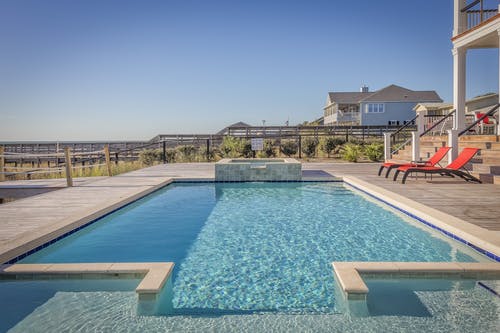A crystal-clear swimming pool can be a prized possession. It instantly becomes a premium highlight of a home or even a hospitality business because people like to soak themselves in soothing water regardless of summer or winter times. But what will you do if it suddenly loses lustre and turns dull? It is not a pleasant scenario to imagine for any homeowner or a business. Still, if you don’t want to face this situation, dig deeper into this problem, learning about the causes, the potential risks, and how to fix it.
Innovative modern enclosures like electric pool covers and auto pool covers can offer excellent relief from this common problem. But before this, you need to check your pool. Is it cloudy? Then, you would have to treat it first. You have to ensure full visibility of the drain at the bottom of your pool’s deep end, which involves thorough cleaning and other considerations. Only then can you avoid hazards.
As per experts, pool water goes through different levels before becoming milky. For example, when it begins to look dull, you may not care much and leave it untreated. As a result, it can transition into a state of haziness, which may give you the view of the pool’s bottom but shrouding most of its details. If ignored, the water can become milky, hiding the deep end completely. You can see the shallow end. While it makes foran unattractive sight, the dirty or green pool water also poses tremendous risks of accidents and injuries. It becomes the breeding ground of harmful bacteria and affects the pool’s circulation system.
Do you wonder why your pool water is looking murky? Here is a brief insight into the root problems and quick fixes to attain the ultimate goal.

Causes of Cloudy Pool Water
When it comes to swimming pool care and maintenance, you have to examine filters, chemical balance, dirt and environmental factors, etc. For hygiene and sanitisation concerns, you use chemicals to treat the water. If you add extra or fewer chemicals, it will interrupt filtration, pH balance, chlorination, hardness of the water, and alkaline levels. It can culminate in cloudiness. Similarly, if the filter is not working correctly, the pool’s circulation will get affected and again, the problem of cloudy water may arise.
Besides, you leave many unwanted materials behind in the water while swimming, such as urine, sweat, sunscreen, and the residue of other cosmetic products you use. You need to add proper sanitisers in the pool to stop them from harming the water quality.
Other than these, you cannot discount environmental factors. Dust, pollen, and leaves can accumulate in the filter and disrupt the cleaning process. Even bird droppings and dead insects are potential health hazards for your property. In this context, you also have to consider run-off water that brings different types of chemicals with it and spoil the pool. Finally, it may not have crossed your mind, but the sun’s UV rays are also detrimental. These can damage hypochlorite ions and evaporate them, affecting the sanitisation of the pool.
You can prevent these elements from entering and interfering with the condition of your swimming pool. Pool covers, as mentioned earlier, can be an efficient and long-term solution. But let’s handle the existing dirt and debris first before getting there.
Cleaning the Dirty Pool Water
Since clogged filters cause cloudiness, pool clarifying chemicals that gather small particles in a clump and help remove them from the swimming pool through coagulation can be reliable. At the same time, you would want to keep pool filters clean to purify water. You can speed up filtering in two ways: using skimmers or bottom drain.
You can stir the pool water with a pool brush to get the particles moving on the surface and skim them out through your skimmer. It will ease the pressure from filters, enabling them to deliver better. Or, if it is an in-ground pool, you can let the bottom drain do the cleaning job. The bottom drain can take care of the smooth flow of clean water while allowing the filter to extract contaminated water from the pool floor.
If you don’t have a bottom drain, you can use a vacuum cleaner in the pool’s centre to do the same thing. In this process, pool flocculant can come in handy. It will collect tiny particles in a clump at the bottom of the pool. Once it happens, you can vacuum clean the dirt and debris manually.
Cloudy pool water can cause recreational illnesses in people due to swallowing while swimming. Plus, it demands lots of intensive efforts for cleaning. So, once your pool becomes sparkling clean, consider investing in modern pool enclosures. These can offer a luxurious touch to any indoor and outdoor pool apart from being functional.

